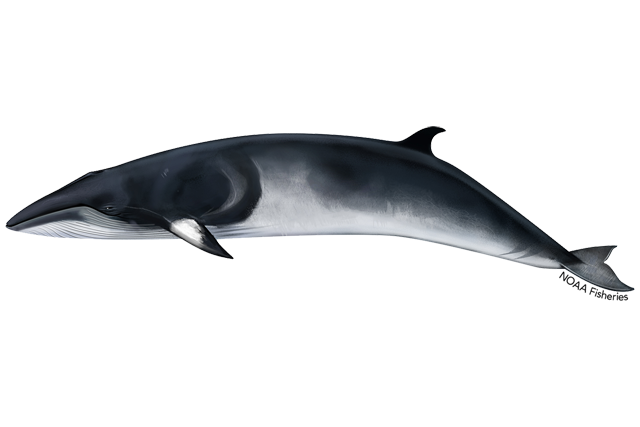Here in New England, we are blessed with a diverse population of whales. Each one plays a unique role in our ecosystem and the marine community.
These magnificent creatures are our neighbors, so let’s get to know them a little better!
Finback Whale
 Photo Credit: NOAA Fisheries
Photo Credit: NOAA FisheriesFinback or fin whales are the second largest whale species on the planet after the blue whale. Though they live in many different oceans around the world, they also grace us with their presence here in New England. It’s easy to spot a fin whale because of the distinctive dorsal fin on its back and their v-shaped head. Fin whales have long lives—they reach physical maturity at about 25 years, and their maximum lifespan is about 90 years.
Like their colleagues, the right whales, fin whales are baleen whales— meaning that they have long, flat plates made of keratin, which they use to filter food from water— in place of teeth. They can also feed in groups with their other New England leviathans: the humpback and minke whales.
Humpback Whale
 Photo Credit: NOAA Fisheries
Photo Credit: NOAA FisheriesSpeaking of humpback whales, today, these guys share the waters of New England with the fin whale, but that wasn’t always the case. Researchers believe that before the moratorium on commercial whaling, humpback whales saw an almost 95% reduction in population size, putting them squarely on the list of critically endangered species.
Humpback whales are easily identifiable because of their long pectoral fins and their namesake feature: the hump on their backs. They travel all across the globe, with some covering distances of nearly 5,000 miles to get to more productive feeding grounds.
When they arrive at these feeding grounds, humpback whales use their baleen to filter out food from large gulps of water. As highly intelligent creatures, they employ a number of techniques to gather food, the most interesting of which is called “group coordinated bubble net feeding.” This process involves using curtains of air bubbles to condense prey and push them toward the surface, where they are consumed by upward-swimming whales.
Minke Whale
 Photo Credit: NOAA Fisheries
Photo Credit: NOAA FisheriesThe northern Minke whale is the smallest baleen whale in North American waters. Their comparatively smaller size makes them easy to recognize and has allowed them to escape the worst exploitation from whalers as they focused on the big ones. As a result, their population levels are the most stable and robust of all the whales we see in the New England area.
Minke whales are usually sighted individually or in small groups of two or three, but loose groupings of up to 400 animals have been seen in feeding areas closer to the poles. In these groups, they also filter fish out of large amounts of water to eat.
Getting familiar with the whales that live in our neighborhood allows us to form a stronger connection with these incredible animals. We hope learning more about whales will bring more people to join our endeavors to work together locally to ensure the whales’ safety and quality of life.
Steady on,
Rob

